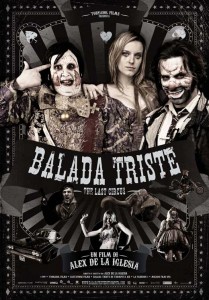
THE LAST CIRCUS
Spain, 2010, 107 minutes. Colour.
Directed by Alex de la Iglesia.
The films of Alex de la Iglesia are an acquired taste. He had the graphic novel mentality before it became fashionable (Day of the Beast and the rather ugly Perdita Durango).
Ugly is one of the words that springs to mind while watching this film. De la Iglesia and many reviewers have opted for the word ‘grotesque’. And, if you are not up to ugly and grotesque, it’s best to give The Last Circus (or its more evocative Spanish title which translates, The Sad Trumpet Ballad), a miss.
The immediate grotesque images are those of the clowns in a circus, 1937. They cavort about and the children in the audience roar with laughter. The military suddenly interrupts the performance. Civil War has broken out and the clowns are commandeered. The principal clown has a son who is not so prone to laughing. The father makes a bequest of a career to his son before he goes into battle.
The time shifts to 1973. General Franco is still in control of Spain. De la Iglesia is offering some kind of fable or allegory about the Spain of the Franco era. And it is not a nice picture.
The son, Javier, is now grown up. He attempts to be the sad clown in the circus, is a threat to Sergio, the happy clown. Javier is also attracted to the tightrope artist, Natalia, who is with Sergio. It is the clash between the two men and the consequences which are the focus for the latter half of the film. There are brutal fights and disfigurements. Javier, grown fat, has a religious apparition, dons odd clothes, including a mitre and goes on a violent rampage, also pursuing Natalia. Sergio, despite his injuries, continues with the circus, though the managers and some of the entertainers, including a midget who is fired from a canon, are continually worried.
The final confrontation takes place on a giant cross above the town, a fight to the death, or to the deaths.
The style of photography highlights the ugliness, the grotesque and the garish world of the circus and of Spain itself. De la Iglesia makes idiosyncratic films that can satisfyingly disturb orquickly alienate his audiences.
1. The title, The Sad Ballad of the Trumpet? More accurate than The Last Circus? The irony of The Last Circus?
2. The work of the director, his eccentricities, the emphasis on the bizarre, the grotesque?
3. Audience response to the grotesque? Uncomfortable, fascinated? The impact on the senses? The appearances of people, disfigurement, clowns? The emotional response, repulsion, interest? The reflective response to the grotesque and its meaning?
4. The prologue, the clowns, the circus in 1937, the look, the performers, the audiences, the children, the pratfalls, the silly antics, the children finding it funny? The clowns and their pride in their work?
5. 1937 to 1973? The civil war, the rebels? The republicans? Franco and his authority? The waging of the war? The violence and the bloodshed? The consequences for Spain for so many decades? The rule of Franco? His coming to the general’s house, hunting, the film’s portrait of Franco and interpretation of him?
6. The military, the colonel, interrupting the circus, the clowns and their reaction, forcing them to go to war, in their clown’s outfit, willing and unwilling?
7. The civil war, the attack, opening the door, the weapons, the clown shooting, the massacre?
8. The clown, Javier, his son? Seeing him at the circus, his admiration for his father? His father’s bequest to him? Being a sad clown?
9. Time passing, Javier getting older, his experience, going to the circus, his size, appearance, the clash with Sergio? With Natalia and his fascination? The other members of the troupe, the manager, the other clowns, the midget and his being fired from the cannon? The women? The place of the circus in Spanish society?
10. Javier as the sad clown, the reaction of the audiences, his being upset? The attraction to Natalia? The clashes with Sergio? His performances, the rivalry?
11. On the road, the differences, the need for money, the onlookers?
12. Javier and Sergio and the fight, vicious, kicking? Sergio and his face? Monstrous? Fixing his mouth? Javier, humiliated, going away naked, escaping, in the cave?
13. Javier and his transformation, the new persona? His clothes, the clown, the sad face? Monstrous? The burns on his face and the patches? His finding the ecclesiastical side – the vision of Mary? The statue? His wearing the mitre? The sad clown, monstrous, in the guise of the church? Allegory for Spain?
14. Javier, terrorising people, the killings, his violent eruptions? The newspapers? People afraid of him? The police?
15. Sergio and the circus, the manager, trying to find the money, continuing the circus?
16. Natalia, the trapeze, her love for Sergio, her relationship with Javier? Not performing? Her being taken, her options, Javier hurt by her choice?
17. The build-up to the climax, climbing the cross, the height, falling over the side?
18. The fight, hanging, the tricks they played on each other, Natalia as the foil? The body count at the end? The pessimism?
19. The value of such an experience, for Spanish audiences, their history? The worldwide audiences?